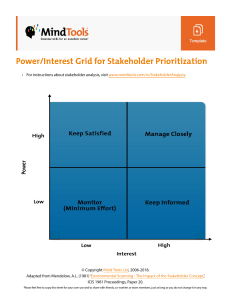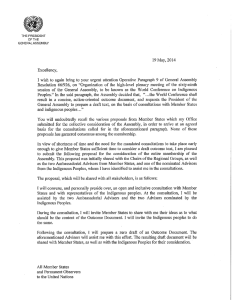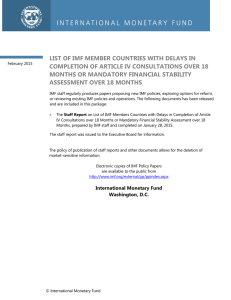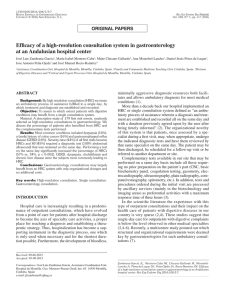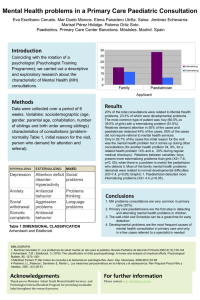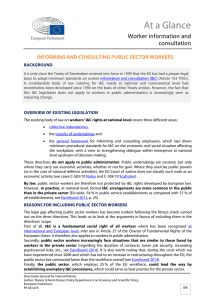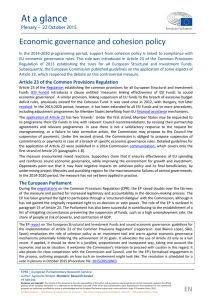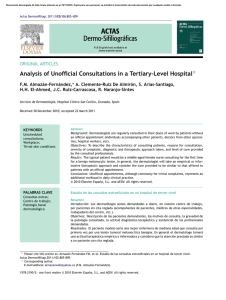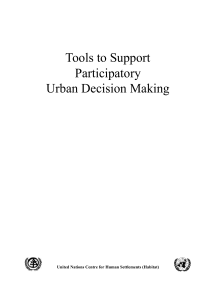Briefing European Parliamentary Research Service
Anuncio
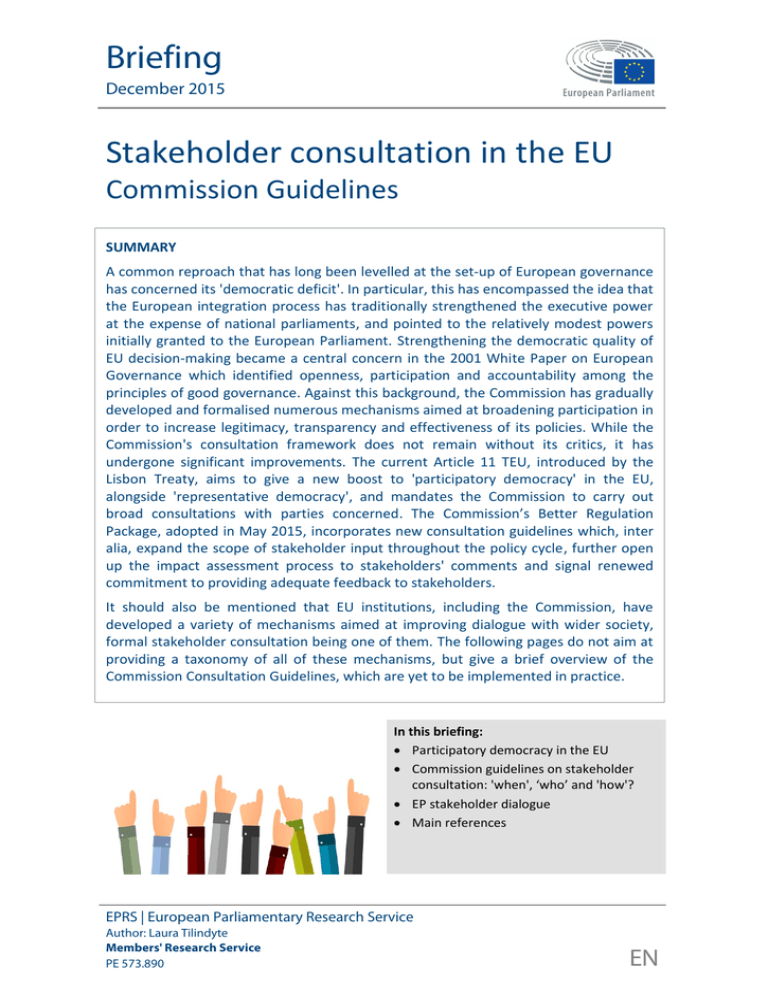
Briefing
December 2015
Stakeholder consultation in the EU
Commission Guidelines
SUMMARY
A common reproach that has long been levelled at the set-up of European governance
has concerned its 'democratic deficit'. In particular, this has encompassed the idea that
the European integration process has traditionally strengthened the executive power
at the expense of national parliaments, and pointed to the relatively modest powers
initially granted to the European Parliament. Strengthening the democratic quality of
EU decision-making became a central concern in the 2001 White Paper on European
Governance which identified openness, participation and accountability among the
principles of good governance. Against this background, the Commission has gradually
developed and formalised numerous mechanisms aimed at broadening participation in
order to increase legitimacy, transparency and effectiveness of its policies. While the
Commission's consultation framework does not remain without its critics, it has
undergone significant improvements. The current Article 11 TEU, introduced by the
Lisbon Treaty, aims to give a new boost to 'participatory democracy' in the EU,
alongside 'representative democracy', and mandates the Commission to carry out
broad consultations with parties concerned. The Commission’s Better Regulation
Package, adopted in May 2015, incorporates new consultation guidelines which, inter
alia, expand the scope of stakeholder input throughout the policy cycle, further open
up the impact assessment process to stakeholders' comments and signal renewed
commitment to providing adequate feedback to stakeholders.
It should also be mentioned that EU institutions, including the Commission, have
developed a variety of mechanisms aimed at improving dialogue with wider society,
formal stakeholder consultation being one of them. The following pages do not aim at
providing a taxonomy of all of these mechanisms, but give a brief overview of the
Commission Consultation Guidelines, which are yet to be implemented in practice.
In this briefing:
Participatory democracy in the EU
Commission guidelines on stakeholder
consultation: 'when', ‘who’ and 'how'?
EP stakeholder dialogue
Main references
EPRS | European Parliamentary Research Service
Author: Laura Tilindyte
Members' Research Service
PE 573.890
EN
EPRS
Stakeholder consultation in the EU
Participatory democracy in the EU
Starting point: provisions on democratic principles
The Treaty on European Union (Article 10) provides that the functioning of the Union
shall be based on representative democracy. European citizens are directly represented
in the European Parliament, while Member States are Representative democracy is generally
represented in the European Council and the Council understood as a system of government
by their Heads of State or Government, and at in which citizens choose their
ministerial level, respectively. Those representatives representatives in elections.
are themselves democratically accountable either to There is no commonly accepted
their national Parliaments, or to their citizens. definition of participatory democracy,
(Article 10(2) TEU).
but it generally envisages an active
Article 11 TEU lays down a complementary principle of role of non-state actors (individual
citizens and civil society organisations)
'participatory democracy', albeit the term is not used
in public life and emphasises various
explicitly. Article 11 sets out the essentials of citizens' forms of citizens' participation in the
involvement in EU decision-making and provides that decision-making
process,
going
the EU institutions shall 'give citizens and beyond representation.
representative associations the opportunity to make
known and publicly exchange their views in all areas of Union action'. It further obliges
the institutions to 'maintain an open, transparent and regular dialogue with
representative associations and civil society' and mandates the Commission to 'carry
out broad consultations with parties concerned in order to ensure that the Union's
actions are coherent and transparent'. Protocol No 2 on the Application of the Principles
of Subsidiarity and Proportionality underlines this duty and specifies that the
Commission, when carrying out such consultations, has to take into account the
regional and local dimension of the action envisaged. The duty to consult broadly does
not apply in cases of exceptional urgency (Article 2).
Background: democratic deficit and beyond
The introduction of Article 11 TEU by the Lisbon Treaty signalled increased willingness
of the EU to engage more actively with its citizens and was meant to give a new boost to
'participatory democracy' in the EU. This, in turn, was a response to the argument of the
'democratic deficit', commonly associated with EU decision-making. While the concept
of democratic deficit has many aspects and lacks a common definition, the core of the
argument is that the system of European governance lacks several elements commonly
associated with democratic government. This in particular refers to the fact that the
transfer of competences to the EU level has generally strengthened the national
executives at the expense of national parliaments: the Council, for example, consisting
of government representatives, is one of the main legislators at EU level. It also points
to the relatively modest powers initially granted to the only directly elected
EU institution – the European Parliament.1
Against this backdrop, for the EU – and especially for the Commission, as the main
initiator of legislation – citizens' involvement became a crucial means to increase the
democratic legitimacy of EU policies.2 The link between participation and legitimacy
was already made in the 2001 White Paper on European Governance, which elevated
openness and participation to principles of good governance and identified them
among the means to improve confidence in EU institutions. In addition, wide
participation throughout the policy cycle was considered to improve the quality,
relevance and effectiveness of EU policies.
Members' Research Service
Page 2 of 10
EPRS
Stakeholder consultation in the EU
EU as a 'laboratory' for participation3
Accordingly, the Commission has gradually developed and formalised a number of
mechanisms to involve the wider citizenry more actively in decision-making and
broadened consultation.4 In 2000, the Commission introduced online consultations as a
tool to reach out to a wide variety of actors and to increase participation.5 The use of
online consultations increased over the years6 and such consultations now figure
prominently in the Commission's current consultation framework. In 2002, the
Commission adopted the general principles and minimum standards for consultation set
out in its Communication 'Towards a reinforced culture of consultation and dialogue:
General principles and minimum standards for consultation of interested parties by the
Commission'. The current Consultation Guidelines discussed below build on and
complement these minimum standards.
The initiatives described above did not remain without their critics, however. The
Commission's approach in particular has been criticised for its lack of inclusiveness,
representativeness, transparency and for the lack of sufficient feedback. For example,
while online consultations are open and were shown to reach out to a broad spectrum
of actors at different levels,7 engagement was nevertheless shown to be uneven.
Research suggested that the consultation processes tend to be dominated by marketrelated interests or interests from older Member States.8 Some have questioned the
Commission's commitment to genuine consultation and openness and dismissed its
approach as an additional administrative hurdle to overcome.9 Further substantial
criticism relates to the fact that 'being heard' in public consultations does not inevitably
translate into 'being listened to'.10 It has repeatedly been suggested that, after input
collection, stakeholders often remain unclear whether, and in how far, this input has
been taken into account in the decision-making and, if it was not, for what reasons.
While Article 296 TFEU does establish the duty for the institutions to state the reasons
upon which a legal act is based, this duty has been considered not a far-reaching one in
terms of giving account.11 The Commission has thus been criticised for not being
responsive enough to stakeholders, contributing to what has been called 'participation
fatigue'.12 For example, its synthesis reports summarizing the views expressed during
consultations were commented upon as being too descriptive and lacking information
on how these views have influenced the Commission's decision.13
Over the years, the Commission has partially responded to (some of) these criticisms by
gradually improving, expanding and upgrading the existing mechanisms in order to
improve their openness, inclusiveness and transparency. 14 Nevertheless, the public
consultation which the Commission carried out on its own consultation guidelines in
2014 still highlighted, among other things, the need to give better feedback and to
better target stakeholders in order to ensure balanced participation. 15
The latest Guidelines on Stakeholder Consultation form a part of the Better Regulation
Package presented by the Commission in May 2015 and should be read in the above
context.16 It is too early to comment on their effectiveness at this early stage.
Members' Research Service
Page 3 of 10
EPRS
Stakeholder consultation in the EU
Commission guidelines on stakeholder consultation: 'when', 'who' and
'how'?
Consultation throughout the 'policy cycle'
As the name suggests, the 'Better Regulation' strategy is essentially aimed at achieving
rules of better quality, meaning well designed, evidence-based measures that will
deliver tangible and sustainable results. This is to be achieved, inter alia, by drawing on
society's input when preparing, adopting and evaluating EU policies. According to the
Better Regulation 'Toolbox', 'stakeholder consultation helps EU law making to be
transparent, well-targeted and coherent and increases credibility and acceptance'.
Accordingly, and in line with Article
11 TEU, participation and openness Figure 1 - The EU Policy cycle
for stakeholders' views are among
the principles of Better Regulation
and stakeholder input is to underpin
the entire 'policy cycle' (Figure 1).
There are different 'points of entry'
for stakeholders to comment on EU
policies, both before and after the
adoption of an EU measure. The new
Better Regulation Package further
expands these 'points of entry' and
broadens the scope of stakeholder
participation. For example, the
Commission has further opened up
parts of the impact assessment
process to stakeholder comments, by
enabling stakeholders to provide Data source: European Commission, 2015.
feedback on, for example, initial
'roadmaps' and 'inception impact assessments'17 at the very start of a new initiative.
The Guidelines also envisage giving stakeholders further opportunity to provide
feedback during an eight-week period following the adoption of a Commission proposal.
It remains to be seen how this will function in practice. Stakeholder 'feedback' is a new
and less formalised tool being developed by the Commission, the initial contours of
which are outlined in the Consultation Guidelines. Consultations are referred to by the
Commission as 'more structured engagement with stakeholders', subject to the
minimum standards. Open internet-based public consultations are mandatory for
initiatives with impact assessments, evaluations, fitness checks 18 and green papers.19
Stakeholder input is thus not limited to the preparation phase of EU legislation but is
applicable both ex ante and ex post, as Figure 1 shows.
Mandatory open internet-based public
consultations on:
Initiatives with Impact Assessments
Evaluations
Fitness Checks
Green Papers
Members' Research Service
Feedback on:
Roadmaps
Inception Impact Assessments
Draft delegated & implementing acts
Legislative proposals
Page 4 of 10
EPRS
Stakeholder consultation in the EU
Finally, the Better Regulation package for the first time envisages stakeholders'
comments on draft delegated and implementing acts.20 The issue of stakeholder
consultation in the preparation phase of delegated acts has also been covered in
negotiations on the new Interinstitutional Agreement on Better Law-making, which is
being finalised at the moment of writing.
Stakeholder consultation: scope, general principles and minimum standards
The Better Regulation Guidelines on stakeholder consultation set out the scope and
principles of stakeholder consultations to be carried out by the Commission services.
Stakeholder consultation is understood as a 'formal process whereby the Commission
collects input and views from stakeholders about its policies'. It does not apply to, for
example, interinstitutional consultations, opinions from national parliaments or specific
frameworks of consultation provided for in the Treaties (such as consultation of the
consultative bodies – the European Economic and Social Committee and the Committee
of the Regions – on the basis of Articles 304 and 307 TFEU). Similarly, consultation of
social partners on the basis of Articles 154-155 TFEU, as well as opinions provided by
committees under 'Comitology' procedures, fall outside the definition of 'stakeholder
consultation'. The same applies to input from citizens within the context of the
European Citizens' Initiative (Article 11(4) TEU), which is subject to a specific set of rules
and procedures.21
The guidelines build on and complement the principles and minimum standards set out
in the 2002 minimum standards for consultation mentioned above. For example, the
principle of participation requires an inclusive approach, by consulting as widely as
possible, while the principles of openness and accountability require making both the
consultation process and its impact on decision-making transparent to those involved.
According to the principle of effectiveness, consultations should take place at a time
when they can still make a difference, while the principle of coherence requires
consistency of consultations across the Commission services.
The minimum standards applying to all consultations include the requirement that all
communication in consultation documents should be clear and concise ('clarity') and
that adequate feedback should be given on how the consultation results have been
taken into account ('feedback'). The latter also includes the requirement to
acknowledge the receipt of a contribution and the publication of contributions. The
guidelines further provide that the Commission should make sure that all relevant
parties are given an opportunity to express their views ('targeting') and that sufficient
time for responses should be provided. Finally, adequate publicity should be ensured
and open public consultations should be published on the 'Your Voice in Europe' portal
('publication').
Scholarly literature, however, has noted that the exact scope of application of the
(2002) minimum standards is far from clear and that they have been applied
inconsistently. As noted above, there is a broad variety of tools deployed to organise
civil dialogue (stakeholder consultation being one of them) and different sets of rules
governing it. Certain groups participate in a number of them in parallel and in different
capacities. For example, while consultation of the Committee of the Regions on the
basis of the treaties or 'outlook' opinions22 of the Committee at an early stage fall
outside the definition of stakeholder consultation, actors represented in the (networks
of the) Committee can at the same time provide input on identical issues within the
framework of stakeholder consultation subject to minimum standards. The same
Members' Research Service
Page 5 of 10
EPRS
Stakeholder consultation in the EU
argument applies in parallel with regard to the social partners and the European
Economic and Social Committee. According to some, this contributes to some degree of
confusion among stakeholders regarding the scope of minimum standards.23 It is
debatable whether the new guidelines rectify this lack of clarity, especially given the
new distinction between formal consultation (subject to the minimum standards) and
informal feedback.
Definitions: stakeholder 'types' and 'categories'
The guidelines on stakeholder consultation define stakeholder as 'any individual or
entity impacted, addressed or otherwise concerned by an EU intervention'.24 In line
with Article 11(3) TEU, the Commission's aim is an 'inclusive approach by consulting as
broadly as possible' in order to ensure that the entire spectrum of views is taken into
account. In identifying relevant stakeholders in a given case, the Commission will in
particular target those who have an interest in, expertise on or technical knowledge in a
policy area. The guidelines provide a non-exhaustive list of stakeholder categories (see
table below), which takes a broad approach and includes among stakeholders, inter alia,
EU institutions, national governments and parliaments, regional, local and municipal
authorities, research institutions, and others. As noted above, a party's status as
stakeholder does not exclude other (furtherreaching) institutional roles of participation in other The concept of 'stakeholder' originates
from management studies and refers to
capacities.
'any group or individual who can affect
From the Better Regulation Guidelines it also or is affected by the achievement of an
becomes clear that a consultation strategy 'is always organization's purpose' (Freemann,
case-specific' and the group of 'relevant' 1984). This concept is at the core of the
stakeholders to be consulted in a given case will so-called 'stakeholder theory' of the
depend on the nature of the problem. Besides the firm, which was aimed at challenging the
stakeholder 'categories', the guidelines further speak traditional emphasis on 'shareholders'
to include a firm's employees,
of identifying the different 'types' of stakeholders,
customers, suppliers, society and others.
such as those affected by the policy, those having a The concept was later developed in a
stated interest in it or those who will have to theory of business ethics and is central
implement it.25 The Better Regulation Guidelines in, for example, the field of corporate
underline the importance of targeting those public governance and Corporate Social
authorities ultimately entrusted with application and Responsibility (CSR).
enforcement tasks in order to incorporate the In this context, a distinction is often
relevant implementation expertise into the made between so-called internal and
initiative.26 This is another illustration of the external stakeholders: those affected by
increased attention paid in the Better Regulation an organisation's actions ('external'
package to implementation issues (as also stakeholders) and those affecting them
evidenced in, for example, the Commission's ('internal' stakeholders).
intention to provide 'implementation plans'27).
According to the guidelines, a successful stakeholder mapping includes targeting groups
which run the risk of being excluded from the consultation process, aiming at
comprehensive coverage, avoiding 'regulatory capture' and, in targeted consultations,
using clear selection criteria.
In the (qualitative) analysis of received contributions, the Commission will take into
account, inter alia, whether respondents reply 'on their behalf' or 'represent specific
interests'. It is noted that those engaging in activities aimed at influencing EU decisionmaking are expected to register in the EU Transparency Register. If they do not, in
analysing replies their contributions will be treated as individual contributions.28 The EU
Members' Research Service
Page 6 of 10
Stakeholder consultation in the EU
EPRS
Transparency Register, based on an Interinstitutional Agreement (IIA) between the
European Parliament and the European Commission, is a voluntary scheme which
covers activities 'carried out with the objective of directly or indirectly influencing the
formulation or implementation of policy and the decision-making processes of the EU
institutions' (par 9).
Stakeholder categories (non-exhaustive list)
Citizen/individual
Industry/business/workers'
organisations
Multi-national/global
National
Small and medium-sized enterprises
Business organisation
Trade union
Chamber of commerce
EU platform, network,
or association
Representing for-profit interests
Representing not-for-profit interests
Representing professions/crafts
National organisation representing for-profit
interests
National organisation representing not-for-profit
interests
National organisation representing professions/
crafts
International/Inter-governmental organisation
Public authority
EU institution
National government
National parliament
Regional/ local/municipal authority
National competent authorities/agencies
Consultancy
Think-tank
Professional consultancy
Law firm
Research/academia
University
School and education establishment
Research institute
Organisation/association
Other
Data source: European Commission, 2015.
Consultation methods, tools and time limits
There are different consultation tools and methods, the selection of which will depend
on a given case. Generally, the guidelines make a distinction between open public
consultations, aimed at reaching out to a wide spectrum of actors, and targeted
consultations, aimed at focusing on specific stakeholders. The latter seeks to strike a
delicate balance between targeting relevant input more efficiently without, however,
granting privileged access. The consultation 'tools' include, inter alia, public online
consultations, stakeholder meetings, workshops, conferences, surveys, interviews,
Members' Research Service
Page 7 of 10
EPRS
Stakeholder consultation in the EU
online discussion fora and others (they are elaborated in Chapter 7 of the Better
Regulation 'Toolbox'). For example, the Toolbox suggests utilizing networks of the
Committee of the Regions whenever an initiative is likely to have significant regional
impacts in order to collect input from regional and local authorities. Generally,
stakeholders should be given a minimum of twelve weeks to comment on initiatives
with impact assessments, evaluations, fitness checks and green papers. The period to
provide feedback is shorter (four weeks) in cases of, for example, evaluation roadmaps
and draft delegated and implementing acts. The tools in a given case will be chosen by
the respective Commission services responsible for running the consultation in
question.
Consultation: and then? Providing feedback to those who contributed
As mentioned above, the requirement to provide adequate feedback to stakeholders
who provide input, and explaining how such input was taken into account in decisionmaking, was already among the requirements set out in the 2002 general principles and
minimum standards for consultation. Yet, its implementation, as discussed above, was
often claimed to be inadequate. The current Guidelines signal a new commitment to
providing adequate feedback to stakeholders to help them understand how their input
has been taken into account and/or why certain suggestions could not be incorporated.
Current Guidelines also provide that consultation work 'should' close with a synopsis
report, documenting every consultation activity, and provide feedback regarding how
stakeholder input has influenced policy. In cases of initiatives with impact assessments
(IA) or evaluations, a synopsis report should be annexed to the respective IA/evaluation
reports which are submitted to the Regulatory Scrutiny Board. The guidelines further
provide that an explanatory memorandum accompanying legislative proposals should
reflect on how stakeholder input has fed into the initiative and, if it did not, why. It
remains to be seen to what extent these measures will lead to genuine improvements
compared to practice to date.
EP stakeholder dialogue
As mentioned, the (formal) stakeholder consultation conducted by the Commission, is
only one among the many ways for the EU institutions to interact with stakeholders and
wider citizenry. Article 11(2) TEU obliges all EU institutions to 'maintain an open,
transparent and regular dialogue with representative associations and civil society'. The
European Parliament too has established various links connecting it with the wider
society and is in the process of intensifying these. EU citizens do not only directly elect
Members of Parliament; they also have the right to petition the Parliament (Article 227
TFEU) and may further contact the Parliament by making citizens' enquiries. Currently,
the Parliament is intensifying dialogue with stakeholders at the national level through
the EP Information Offices (EPIOs) in various Member States. This new form of
cooperation aims at involving stakeholders at the national level more actively in the
legislative work through organising events on legislative initiatives with the
participation of EP rapporteurs. This is intended to become a tool for rapporteurs to
reach out to national stakeholders by consulting directly at the national level on
ongoing EP work. A number of such events on various topics have been carried out
already and the project is on-going at the time of writing.
Members' Research Service
Page 8 of 10
EPRS
Stakeholder consultation in the EU
Main references
Fazi, E. and Smith, J. (2006), Civil Dialogue: Making it Work Better, Study commissioned
by the Civil Society Contact Group.
Kohler-Koch, B. (2008), Does Participatory Governance Hold its Promises?, in: KohlerKoch, B., Larat, F., (Eds.), Efficient and democratic governance in the European Union.
(Mannheim CONNEX Report Series 09).p. 265-295.
Obradovic, D., Vizcaino, A. (2006), 'Good Governance Requirements Concerning the
Participation of Interest Groups in EU Consultations', in: Common Market Law Review,
Vol. 43, p. 1049-1085.
Quittkat, C. and Finke, B. (2008), 'The EU Consultation Regime', in: Kohler-Koch, B.
Bièvre, D. and Maloney, W. (eds.), Opening EU-governance to civil society: gains and
challenges (Mannheim, CONNEX Report Series 05), p. 183-222.
Quittkat, C. (2011), 'The European Commission's Online Consultations: A Success
Story?', in: Journal of Common Market Studies, Vol. 49, No. 3, p. 653-674.
Quittkat, C. and Kotzian, P. (2011), 'Lobbying via Consultation - Territorial and
Functional Interests in the Commission's Consultation Regime', in: Journal of European
Integration, Vol. 33, No. 4, p. 401-418.
Weiler, J., Haltern, U. and Mayer, F. (1995), 'European Democracy and its Critique',
in: West European Politics, Vol. 18, No. 3, p. 4-39.
Endnotes
1
2
3
4
5
6
7
8
9
10
11
12
13
14
15
16
17
See in particular Weiler, J., Haltern, U. and Mayer, F. (1995), 'European Democracy and its Critique', in: West
European Politics, Vol. 18, No. 3, p. 4.
For example, Quittkat, C. and Finke, B. (2008), 'The EU Consultation Regime', in: Kohler-Koch, B., Bièvre, D. and
Maloney, W. (eds.), Opening EU-governance to civil society: gains and challenges (Mannheim, CONNEX Report
Series 05), p. 189.
The term comes from Kohler-Koch, B. (2008), Does Participatory Governance Hold its Promises?, in: Kohler-Koch,
B., Larat, F., (Eds.), Efficient and democratic governance in the European Union. (Mannheim CONNEX Report Series
09), p. 271.
Kohler-Koch, B. (2008).
Quittkat, C. (2011), 'The European Commission's Online Consultations: A Success Story?', in: Journal of Common
Market Studies, Vol. 49, No. 3, p. 654 et seq.
Ibid., p. 658 et seq.
Quittkat, C. and Kotzian, P. (2011), 'Lobbying via Consultation - Territorial and Functional Interests in the
Commission's Consultation Regime', in: Journal of European Integration, Vol. 33, No. 4, p. 407 and 410.
For example, Kohler-Koch, B. (2008), p. 280; Quittkat, C. (2011).
See in particular Quitkatt (2011) and references therein.
The terms come from Chalmers, D., Davies, G. and Monti, G (2014), European Union Law (Cambridge University
Press), p. 410.
Ibid., p. 408 et seq.
For example, Fazi, E. and Smith, J. (2006), Civil Dialogue: Making it Work Better, Study commissioned by the Civil
Society Contact Group, p. 7.
Ibid., p. 409 and references there.
Quittkat, C. and Finke, B. (2008).
This consultation related to consultations carried out in the context of evaluations and impact assessments and
took place from 30 June 2014 to 30 September 2014: Results of Public Consultation on the Commission's Draft
Stakeholder Consultation Guidelines, Summary Report.
The new Guidelines replace the previous standalone guidelines on impact assessment, evaluation and
implementation and complement the existing guidelines on stakeholder consultation as set out in the mentioned
minimum standards (BR Guidelines, p. 6).
A 'Roadmap' is a brief document informing stakeholders about planned consultation work, impact assessments,
evaluations and fitness checks which is published at an early stage to help stakeholders to prepare input while an
'inception impact assessment' is an ‘initial description of the problem, its underlying drivers, the policy objectives,
policy options and the economic, social, environmental impacts of those policy options’, Better Regulation
Guidelines, p. 90 (Glossary).
Members' Research Service
Page 9 of 10
EPRS
18
19
20
21
22
23
24
25
26
27
28
Stakeholder consultation in the EU
A Fitness check is an evaluation of the effectiveness, efficiency, coherence, relevance and EU added-value of a
number of related EU interventions in a policy area/business sector. The quality of major fitness check reports is
checked by the Regulatory Scrutiny Board, Better Regulation Guidelines, p. 89 (Glossary).
Green Papers are defined as 'documents published by the European Commission to stimulate discussion on given
topics at European level. They invite the relevant parties (bodies or individuals) to participate in a consultation
process and debate on the basis of the proposals they put forward. Green Papers may give rise to legislative
developments that are then outlined in White Papers.'
In this regard, some exceptions apply; see Better Regulation Guidelines, p. 67.
In particular those set out on Regulation 211/2011 of the European Parliament and of the Council on the Citizens'
Initiative.
As foreseen in par. 8 of the Protocol on the Cooperation between the European Commission and the Committee
of the Regions.
Obradovic, D., Vizcaino, A. (2006), 'Good Governance Requirements Concerning the Participation of Interest
Groups in EU Consultations', in: Common Market Law Review, Vol. 43, p. 1054 et seq. See also Fazi, E. and Smith, J.
(2006), p. 9.
Better Regulation Guidelines, p. 91 (Glossary).
Better Regulation Guidelines, p. 74.
Better Regulation guidelines, p. 34.
An implementation plan is 'a SWD [Staff Working Document] that is prepared in order to support the
implementation work by the Commission and the Member States of certain new Directives and Regulations. (...) It
identifies implementation needs and actions required of different entities to ensure a timely, effective and
consistent implementation' (Better Regulation Guidelines, p. 90).
Better Regulation Guidelines, p. 80.
Disclaimer and Copyright
The content of this document is the sole responsibility of the author and any opinions expressed therein
do not necessarily represent the official position of the European Parliament. It is addressed to the
Members and staff of the EP for their parliamentary work. Reproduction and translation for noncommercial purposes are authorised, provided the source is acknowledged and the European Parliament is
given prior notice and sent a copy.
© European Union, 2015.
Photo credits: © queidea / Fotolia.
[email protected]
http://www.eprs.ep.parl.union.eu (intranet)
http://www.europarl.europa.eu/thinktank (internet)
http://epthinktank.eu (blog)
Members' Research Service
Page 10 of 10
